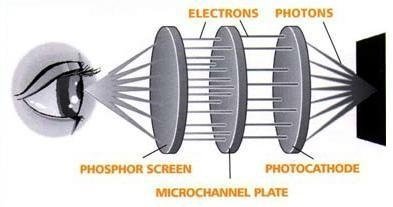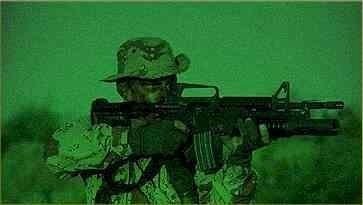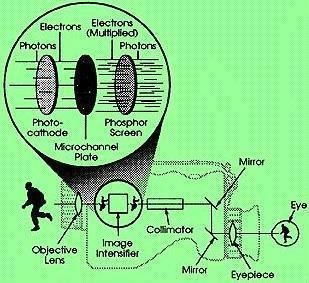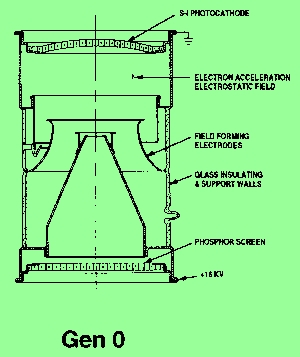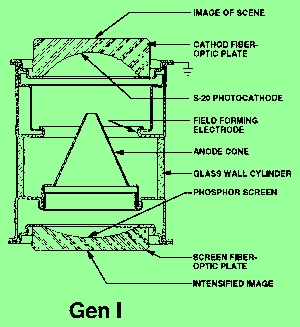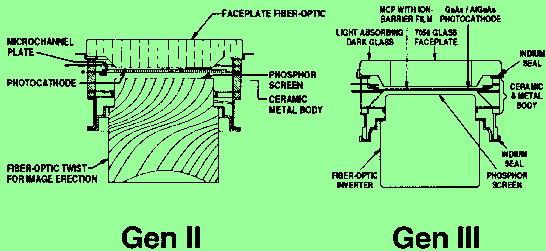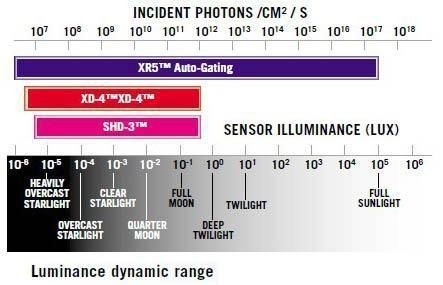Overall Cost of Ownership:
Evaluation factors that impact the actual cost of acquiring a night vision capability are image tube life (referred to as "reliability"), warranty coverage, repair availability, service support, and overall workmanship as an indicator of quality. When evaluating night vision equipment, the initial acquisition cost does not equate to the cost of ownership. How often will you need a new image tube? What is the likelihood for repairs? Are batteries available? What about exposure to bright lights? All image intensifiers will "wear out" over time due to gases generated within the tube that migrate to the photocathode and slowly kill it. Because of this, characteristics such as reliability, a bright-source protection (BSP) circuit, and the presence or absence of an ion-barrier film on the microchannel plate are important. mil specs describe procedures for projecting reliability. You should know what the reliability is for the tube you evaluate.
An important factor that can influence reliability is the voltage used to produce gain. If an image tube is "driven" hard to produce high gain, it will accelerate the production of gases and more quickly kill the ability to convert light into electrons.
A final evaluation criteria is to determine whether or not the night vision device incorporates automatic protection for the image intensifier when it is exposed to high-light conditions or bright-light sources. Image tubes manufactured by Tiangying have a BSP circuit built into the image intensifier. This circuit automatically reduces the voltage to the photocathode when the system is exposed to bright light sources. The BSP feature protects the image tube and enhances its life. If there is doubt, consult the warranty; does it exclude exposure to high light or bright lights?
- Note 1: Generation classification:
Some night vision advertising has presented confusing information listing Russian equipment as Gen I, Gen II, and Gen III, when in fact, by worldwide classification it is Gen 0, Gen I, and Gen II, respectively.
- Note 2: Reconditioned Generation II:
While the prices of "reconditioned" Gen II systems may be attractive, be aware that the hours of remaining life and photosensitivity performance cannot be restored to Gen II tubes. "Reconditioned" usually means the system has a new or repaired power supply but the photosensitivity will be lower, the SNR will be lower, and the remaining life will be less. Some reconditioned units may be operating at below acceptable minimums and few companies possess the necessary test equipment to evaluate the tube's level of performance.
The military specifications for Gen II require a reliability of 2,000 hours of operating time (Tiangying's new Gen II image intensifier has tested to well beyond the military specification). This situation does not pertain to Gen III equipment. Due to the presence of an ion-barrier film in Gen III devices, the gallium-arsenide photocathode is protected from degradation and the life and performance are extended many times longer than Gen II.
Construction
The physical characteristics of NV units are usually designed with three factors in mind, compactness, weight and observation distance. Unfortunately sometimes these characteristics are in conflict with one another. For example, greater observation distances can be provided by a unit with a larger lens with the inherent disadvantage that the device will be bigger in size and weight. The customer has to decide which characteristic is a priority and buy accordingly.
One factor, which is especially important, is the construction of NV rifle scope — it must be extremely rugged to withstand the shock of up to 500 Gs along the optical axis due to recoil. In this harsh environment the cross hairs, sighting posts and targeting adjustments must remain unmoved and be visible in all types of viewing conditions. Many NV rifles copes currently offered on the market are not designed to compensate for these stresses (cal. .365H&H, .416Rirby) and may have weak mounting and zeroing-in systems. This will require repeated readjustments to maintain accuracy. This is a complicated subject that cannot be discussed properly in a short article. We encourage you to contact our company for a special consultation on the subject.
BLACK SPOTS ON THE SCREEN
As you look through a night vision device you may notice black spots on the screen. A NVD is similar to a television screen and attracts dust and dirt. Typically these spots can be cleaned. However, this may also be a spot in the tube itself. This is normal. Most tubes will have some spots in them. These black spots will not affect the performance or reliability of the night vision device.
Distance of observation and identification
The buyer should take into account that the distance of observation and identification, which night vision devices provide, depends on the level of night illumination, clarity of atmosphere and contrast between an object of observation and background. When illumination increases the distance of identification becomes higher. When illumination reduces it becomes lower.
The table of average distance of night observation and identification of an object is given below (based on the domestic and foreign data).
| USA Identification
range |
Full moon 0.1lux (meters) |
Quarter moon 0.05lux (meters) |
Starlight 0.001lux (meters) |
Overcast 0.0001lux (meters) |
| Generation I Deer Human Ship |
182 228 685 |
137 182 457 |
91 137 274 |
68 91 137 |
| Generation II Deer Human Ship |
274 457 914 |
205 411 731 |
160 274 502 |
91 137 274 |
| Generation III Deer Human Ship |
365 594 1142 |
274 457 914 |
205 342 731 |
137 182 502 |
| Generation.IIII Deer Human Ship |
457 685 1280 |
365 548 1051 |
251 365 868 |
182 228 594 |
| International Identification range
(human) |
Full moon 0.1lux
( meters) |
Half moon
0.05lux
(meters) |
Quartermoon 0.01lux
( meters) |
Starlight
0.001lux
( meters) |
Overcast 0.0001lux
( meters) |
| Without nightvision device |
230 |
130 |
45 |
_________ |
________ |
| Generation I |
300 |
200 |
150 |
100 |
50 |
| Generation II |
630 |
630 |
590 |
390 |
145 |
| Generation III |
810 |
810 |
770 |
530 |
200 |

